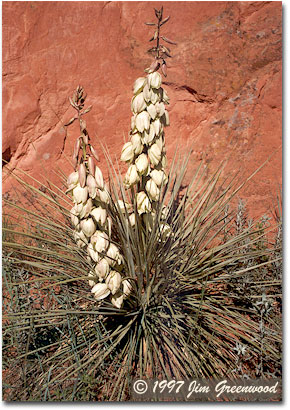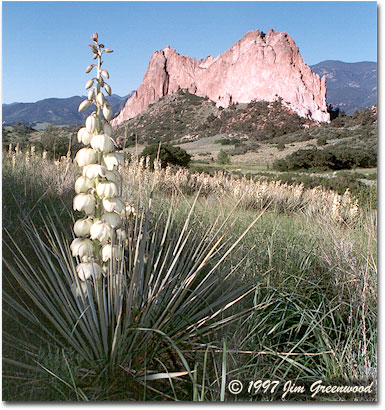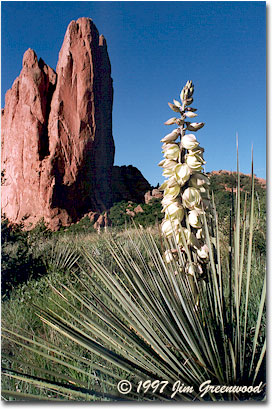|
|
 Species Profile... The Soapweed Yucca
Text and photography Copyright Jim Greenwood
One of the most interesting and studied aspects concerning yuccas is the relationship between the genus Yucca and the genus Tegeticula yuccasella, also known as the Tegeticula moth, and more generally and aptly referred to as the yucca moth. For the most part, the information in this article is specific to the species Yucca glauca, and more generally to the genus Tegeticula yuccasella, since I am not knowledgeable about most of the other species of yucca nor have I studied any single particular species of the yucca moth in detail. The Yucca glauca is a plant that is well suited to thrive in the semi-arid climate generally found throughout its range. The word glauca is from the Latin root "glaucus" which is defined as a bluish or greenish-gray color. Many plants have evolved with this characteristic color, which helps them to reflect the intense sunlight usually present in a semi-arid or arid climate. The soapweed yucca has evolved with many other features which enable it to survive long periods of time without a significant supply of water. The long, pointed, dagger-like spines are actually the plant's leaves. The soapweed yucca is sometimes mistakenly referred to as the Spanish Bayonet. However, that name is more correctly a reference to a very similar species, the banana yucca. The spines of the soapweed yucca have a concave, gutter-like upper surface that helps to catch and direct rain and melting snow down into the plant's roots. The roots also gather and store water in three ways. The root system consist of a large fleshy storage root, a network of small roots directly below the surface that gather water quickly before it runs off or evaporates, and a long tap root that extends as deep as three feet to collect water further down. I've also been told that the roots secrete a chemical enzyme into the soil surrounding the plant which tends to inhibit other plants from taking root nearby, decreasing competition for water and other resources. However, I haven't been able to find any direct reference to this characteristic that would support or verify the claim in anything I've read about the soapweed yucca or any other yucca species. Plants can grow to a height of up to six feet. Mature specimens have been estimated to be about fifty years old. They grow solitarily, or in small dense clusters of a few plants. Individual plants or clusters normally grow widely scattered from each other, although they can also be found in more densely populated evenly spaced stands as in the photograph to the right. The soapweed yucca is extremely resistant to destruction by fire, or by natural or mechanical disturbances such as animal consumption or plowing. Remaining roots can and usually do regenerate into a new plant within only a few years after the plant has been severely damaged, destroyed or removed. The plant is also resistant to herbicides.
As mentioned earlier, the genus Yucca, including the soapweed yucca, and the yucca moth have an interesting relationship, known as "coevolved mutualism". Coevolution is defined as a state in which two organisms have become nearly completely dependent on each other for their existence and continued survival. Mutualism between two organisms exists when both benefit from the relationship between them and neither is harmed by it. The genus Tegeticula yuccasella consists of many different species, just as does the genus Yucca. The complete relationship between all the different species of both is not known. A particular species of yucca may serve as host to multiple species of yucca moths, and a particular species of yucca moth may populate multiple species of yucca. Yuccas depend exclusively on yucca moths for pollination, which results in seed production and genetic diversity. Likewise, yuccas are the only known host plants for the yucca moths. Yucca moths remain inside the closed flowers during the day for protection. Mating takes place inside the flowers. The male moths do not have a role in pollination. At night, when the flowers are open, the female will collect a load of very sticky pollen from a flower's anther. She will form the pollen into a small ball with mouth parts that have evolved for this purpose. She will then fly to the flowers of other plants to deposit her eggs, with the pollen ball clinging to the underside of her body and held in place by her tentacles. After laying her eggs in a flower's ovary, she will deliberately pollinate its stigma with a portion of the pollen she has collected. The moth thus guarantees that the flowers in which she has just deposited her eggs will not abort due to a lack of pollination. She may also deposit eggs in developing fruit. Other factors such as beetle infestation may however, cause the flower to subsequently abort, after it has been pollinated. It's not known what determines how many eggs a moth will deposit in a single flower or how many total eggs she will deposit. A greater number of eggs would tend to favor the moth in the short term. Of course, this would result in a greater number of seeds that are consumed by the larvae. Yucca populations would thus decrease in the long run. Moth numbers would then subsequently decrease. Mutualism would be violated. Apparently, a female will not deposit eggs in a flower in which she or another moth has already deposited eggs. The manner in which she senses this information is also not understood. A reason could possibly be that the moths leave minute traces of scented chemical indicators called pheromones in the flowers they have visited. It has also been theorized that the plant has some control over the situation. It may produce a large number of flowers, but then spontaneously abort some of its flowers that have been pollinated. The plant could be stressed by too much fruit production. Thus, if a moth lays more of its eggs in less flowers, there would be a greater chance that none of its larvae would survive. The moth is more likely to produce offspring by laying smaller numbers of
Unpollinated or aborted flowers will wilt and drop off the stalk usually by around early July. The remaining pollinated flowers will become fruit and then ripen into woody pods during July and August. Developing larvae inside a pod will normally only consume less than a third of the pod's total yield of seeds, thus having a negligible negative impact on the plant. Mature larvae will burrow through the surface of the pod and drop to the ground or descend on a thread of silk. In September, the pods dry up and split open. The seeds begin to be dispersed, mostly by wind action. Wind will shake them loose from the pod. The seeds are thin, disk-shaped and very lightweight, which increases the likelihood that they will be carried a good distance from it's parent plant. The yucca was an extremely useful plant to native Americans. Its leaves are very fibrous. The strong fibers were used to make string and twine which was then used to make a variety of items such as sandals, mats, baskets, cloth, brushes, etc. The tips of the spines were used as needles for sewing. The roots contain a substance that belongs to a group of compounds called saponins, which have detergent properties (sapo is the Latin word for soap). The roots were made into a pulp and used as mild soap and shampoo. This, of course, is why the plant received its common English name, although other varieties of yucca and many other plants contain saponins as well. There is evidence that saponins increase a plant's resistance to fungal attack. Parts of the plant are edible. As the plant prepared to flower, the young stalks, which resemble asparagus, were harvested and cooked. New seed pods were roasted and peeled before eaten. Mature pods were ground into flower. The spines, flowers and roots were used to make teas that were consumed for medicinal purposes. Jim Greenwood - NPN 013 Comments on NPN landscape photography articles? Send them to the editor. |
|
|
 The species Yucca glauca, commonly known as the soapweed yucca, is one of the more prevalent members of the genus Yucca, of which there are a total of about forty different species. The largest yucca is the Joshua tree (species Yucca brevifolia), which can reach a height of forty feet, and grows in the desert environments of California, Nevada and Arizona. The range of the soapweed yucca is much more widespread, extending from extreme southeastern Alberta, Canada, south through a total of thirteen U.S. states. It can be found in prairie and grassland areas of the high plains states of the central and western U.S. Its range extends south through Colorado, Texas, New Mexico and Arizona in the southwestern U.S. It is generally found at elevations beginning at about 2,500 feet in northern sections of its range, and up onto the high mesas and Rocky Mountain foothills of the Southwest to about 9,500 feet.
The species Yucca glauca, commonly known as the soapweed yucca, is one of the more prevalent members of the genus Yucca, of which there are a total of about forty different species. The largest yucca is the Joshua tree (species Yucca brevifolia), which can reach a height of forty feet, and grows in the desert environments of California, Nevada and Arizona. The range of the soapweed yucca is much more widespread, extending from extreme southeastern Alberta, Canada, south through a total of thirteen U.S. states. It can be found in prairie and grassland areas of the high plains states of the central and western U.S. Its range extends south through Colorado, Texas, New Mexico and Arizona in the southwestern U.S. It is generally found at elevations beginning at about 2,500 feet in northern sections of its range, and up onto the high mesas and Rocky Mountain foothills of the Southwest to about 9,500 feet. The soapweed yucca usually blooms in June and July. This is, of course, when it is at its photogenic peak. The first blooms do no normally appear until the plant is five or six years old. Thereafter it will only bloom every two or three years. Some years, when conditions are favorable, they bloom in very prolific numbers. Other years, only a relative few will bloom. A plant will quickly produce a long vertical stalk called a raceme inflorescence, on which the flowers appear. Young flowers have a purple tint. Mature flowers are greenish-white in color. Between twenty and sixty flowers will be produced per stalk, depending on plant size and growing conditions. The flowers have three petals and three sepals, which close during the day and open at night. Each flower has one pistil and six stamen. The pistil is the flower's structure that contains its female reproductive system. This includes the stigma, which is located at the tip of the pistil to receive the pollen, and the ovary which contains the eggs. The stamen contain the plant's male reproductive system, which produces the pollen. A component at the tip of each stamen called the anther secretes the pollen.
The soapweed yucca usually blooms in June and July. This is, of course, when it is at its photogenic peak. The first blooms do no normally appear until the plant is five or six years old. Thereafter it will only bloom every two or three years. Some years, when conditions are favorable, they bloom in very prolific numbers. Other years, only a relative few will bloom. A plant will quickly produce a long vertical stalk called a raceme inflorescence, on which the flowers appear. Young flowers have a purple tint. Mature flowers are greenish-white in color. Between twenty and sixty flowers will be produced per stalk, depending on plant size and growing conditions. The flowers have three petals and three sepals, which close during the day and open at night. Each flower has one pistil and six stamen. The pistil is the flower's structure that contains its female reproductive system. This includes the stigma, which is located at the tip of the pistil to receive the pollen, and the ovary which contains the eggs. The stamen contain the plant's male reproductive system, which produces the pollen. A component at the tip of each stamen called the anther secretes the pollen. eggs in the flowers of many more plants. In general, what is completely understood is that by pollinating the plant, the moth benefits from the production of seeds on which its developing larvae totally depend for food. The plant benefits because pollination can not be achieved by any other means. The soapweed yucca does have the ability to clone itself vegetatively. However, without pollination, the yucca's genetic diversity resulting from sexual reproduction would rapidly decrease and it would become extinct, as would the Tegeticula moth.
eggs in the flowers of many more plants. In general, what is completely understood is that by pollinating the plant, the moth benefits from the production of seeds on which its developing larvae totally depend for food. The plant benefits because pollination can not be achieved by any other means. The soapweed yucca does have the ability to clone itself vegetatively. However, without pollination, the yucca's genetic diversity resulting from sexual reproduction would rapidly decrease and it would become extinct, as would the Tegeticula moth.